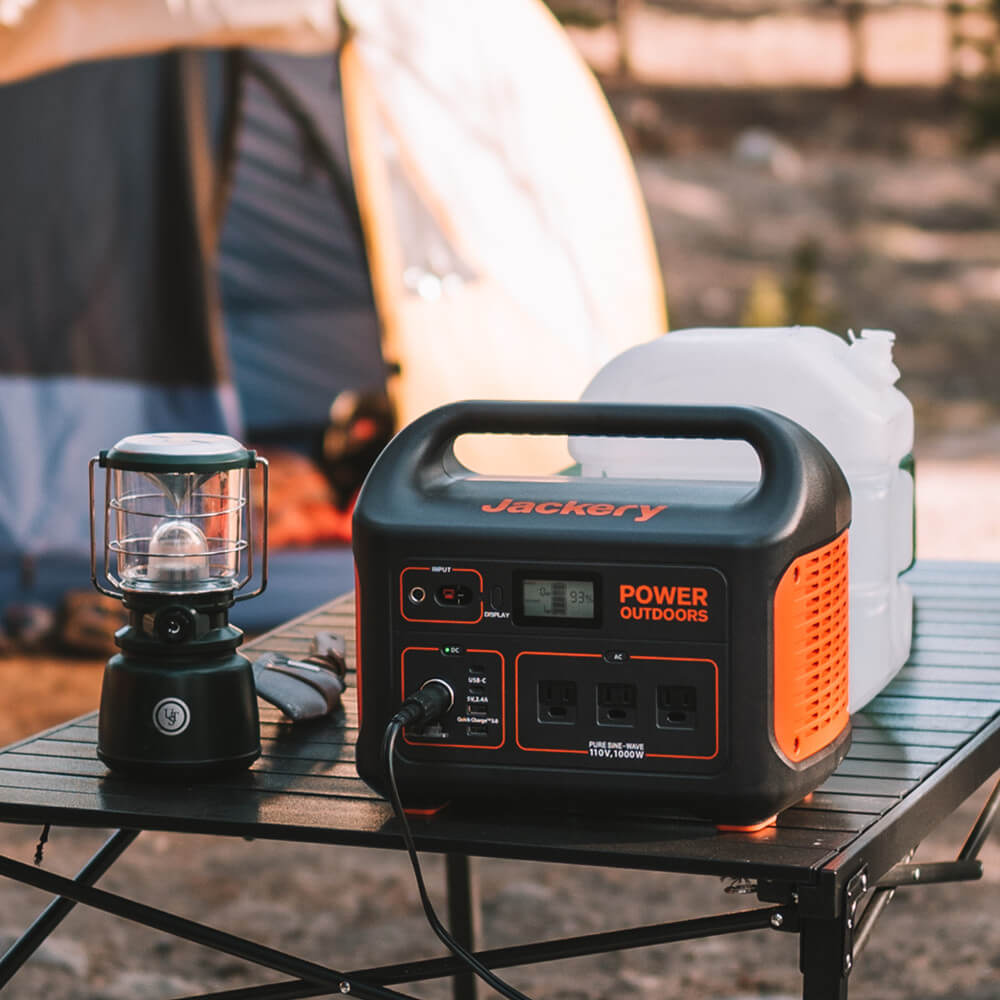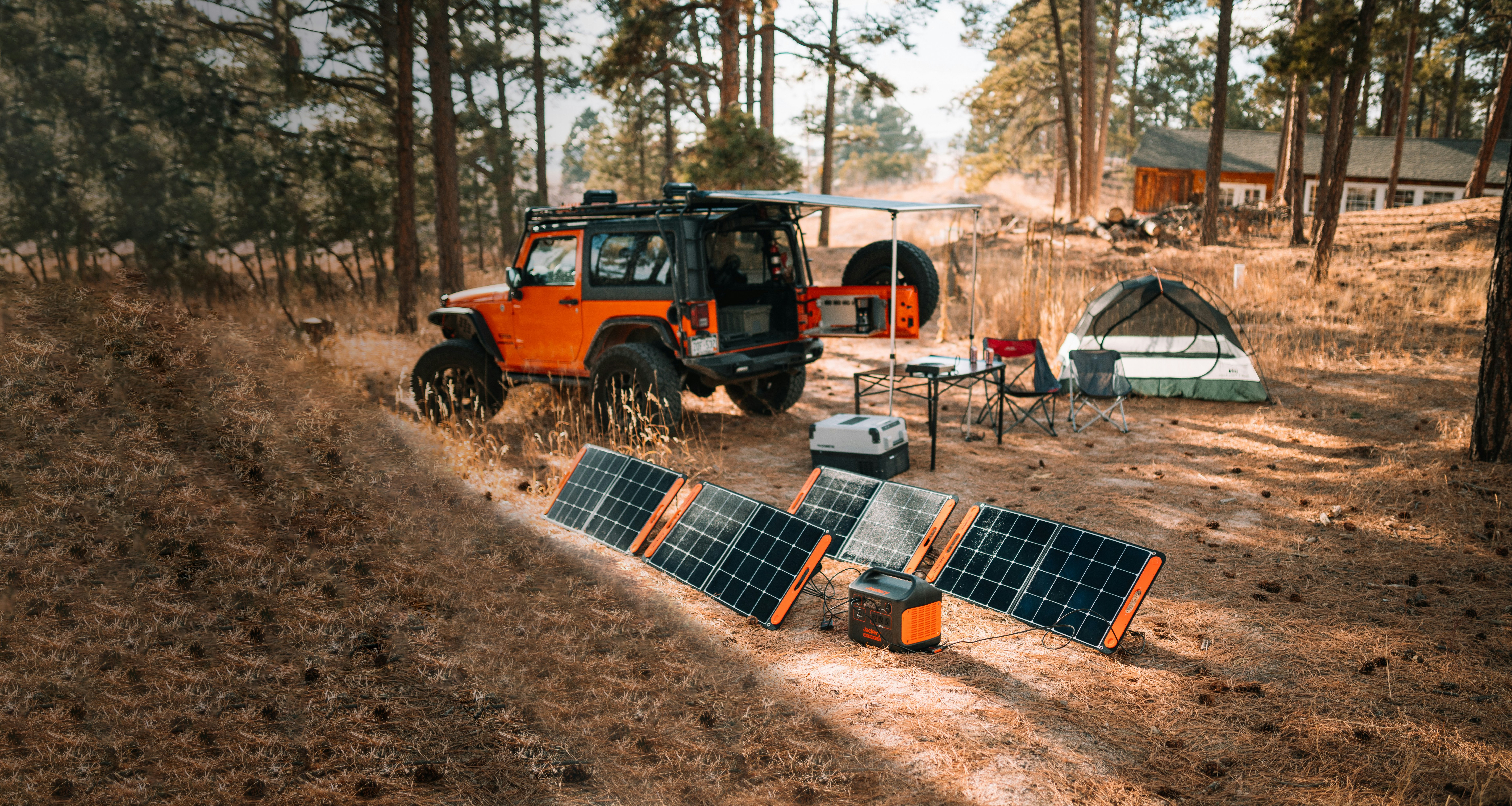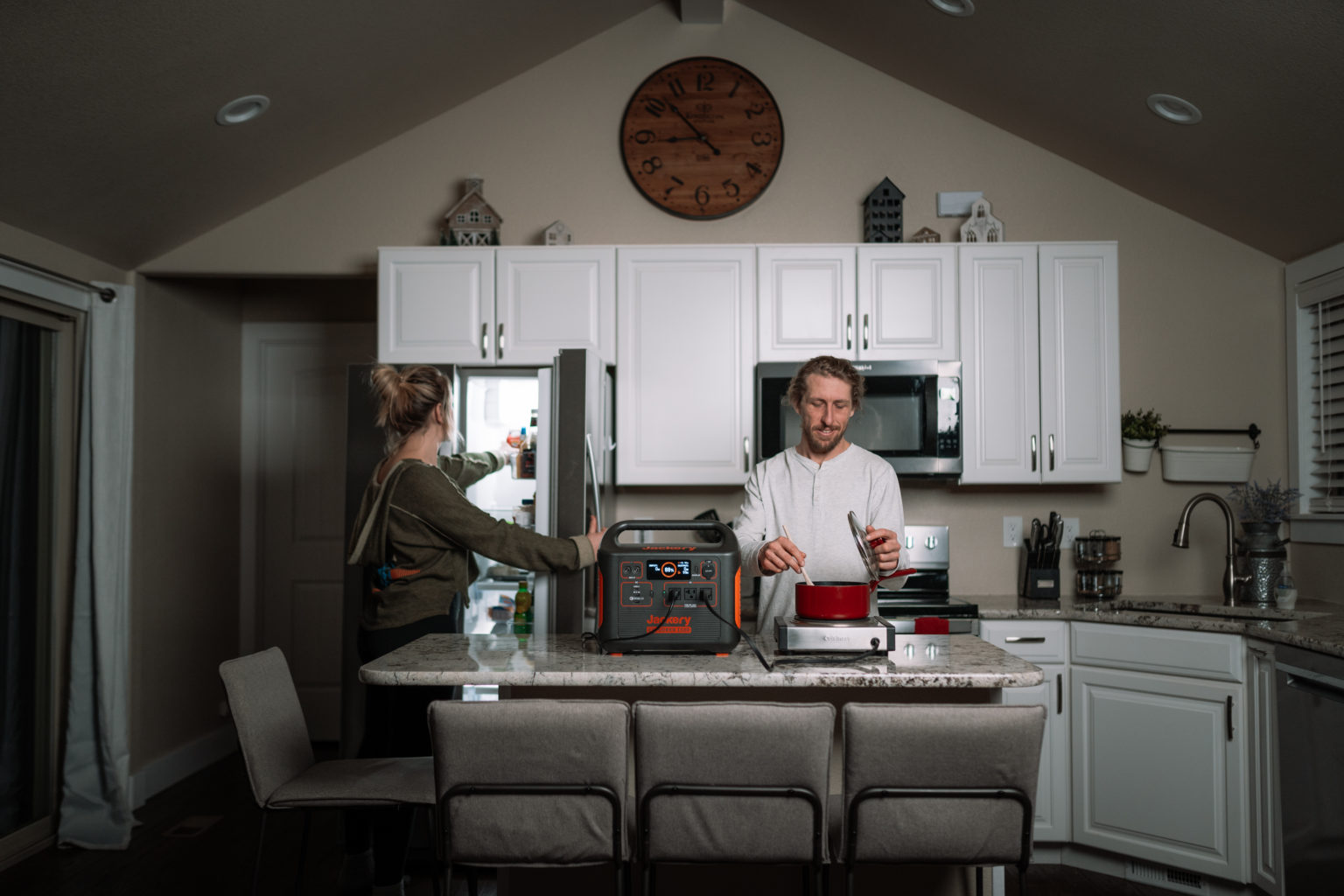Heavy rains, strong winds, lightning, and icy power lines are some of the leading causes of power outages. When these blackouts inevitably occur, your refrigerator will shut down and leave your household at risk of food contamination. This is even more devastating for people who store medicine in the fridge. The best thing you can do for your household is to get a generator to minimize inconvenience. One of the best options is the Jackery 1000, which can power a refrigerator.
What Is the Jackery 1000?

The Jackery 1000 is a portable, rechargeable battery-powered generator that you can use to power almost any appliance. You charge the Jackery power station via solar energy or the included AC or DC adapters. The power station collects and stores current from the solar panels or wall outlets. It then diverts the energy into an inbuilt AC so that you can use it as a generator for a refrigerator and other appliances.
How can the Jackery 1000 Power a Refrigerator?
This generator’s 1002Wh battery supplies 1000W power, enough to run most residential refrigerators. The Jackery 1000 can power a refrigerator below the 1000-watt mark for about seven hours. The three pure-sine wave AC outlet lets you safely use the power station inverter to run delicate electronics.
How Many Watts Does a Refrigerator Use?
On average, a residential refrigerator uses around 350 to 780 watts. A larger, older unit may use between 700 and 1000 watts. The rate of energy consumption varies based on several factors. They include:
- Size of the fridge – A mini-fridge requires about 50 to 100 watts, depending on how often you use it. But large volume units like side-by-side refrigerators need more power to run.
- Refrigeration technology – Old refrigerators are less energy efficient and can use about 1000kWh annually, while a modern fridge can use as little as 336kWh.
- Fridge’s location – A refrigerator works by pumping heat from the inside to the outside. So, putting your fridge in a poorly ventilated space hampers airflow and affects the unit’s ability to dissipate heat which overworks the compressor, increasing energy consumption.
- Season – Refrigerators use more energy in summer than in winter due to the high ambient temperature.
- Usage – If you frequently open the fridge, the compressor will need to work extra hard to cool the food. Also, a reasonably stocked fridge retains cold better than an empty one. Once you open the door to a nearly empty fridge, more warm air replaces the cold, and the unit will need to work harder to cool the space.
- Temperature setting – Setting your fridge temperature 1°C colder than the recommended 4 to 5°C can increase your monthly energy consumption by 5% to 10%.
How to Estimate Your Refrigerator’s Power Consumption
The easiest way to determine your refrigerator’s power consumption rate is by using the unit’s ENERGY STAR rating. Find your refrigerator’s model number, check for its ENERGY STAR rating, and you should see its estimated annual energy consumption.
If, for example, if it reads 225kWh, your refrigerator uses 225,000 watts per hour in a year. So, divide 225,000 by 365 days in a year to get 616.44 watts per hour per day. Next, divide 616.44 by the number of hours you run the unit daily, say 24 hours, to get 25.68 average running watts.
Note that a fridge cycles on and off throughout the day. The compressor only turns on when it needs to lower the unit’s internal temperature. Most refrigerators cycle for about one-third of the day, which is eight hours. So, to find the fridge’s actual power consumption rate, you multiply the wattage by 1/3. In this case, 25.68 x 1/3 equals 8.56 watts.
Alternatively, you can calculate the fridge’s power usage using the nameplate amperage rating. Look for a sticker inside your fridge that shows the volts and amperes your unit uses when running. Multiplying the volts and amperes will tell you how much energy your fridge consumes. Let’s say the refrigerator runs on 120 volts, and the nameplate’s amperage is 4 amps. In this case, you multiply 120 x 4 to get 480 watts. Since the estimated fridge usage is about eight hours, to get the total daily power consumption, you multiply 480 x 8 to get 3840Wh, which equals 3.84kWh/day. Annually, this translates to 3.84kWh x 365 days =1401.6kWh/year.
The above methods may be inaccurate since your fridge doesn’t always consume the rated wattage. A faulty unit may run for about 16 hours a day rather than the usual eight, and the calculation methods don’t account for this. The most accurate way to determine your fridge’s power consumption rate is by using a power meter. You only need to plug the meter into a wall outlet, then plug in your refrigerator. The device measures the fridge energy usage over a specific period.
How to Power a Refrigerator Using the Jackery 1000
Before connecting the Jackery 1000 to your fridge, determine power usage with any of the above methods. Note that a refrigerator uses more energy to start up the compressor motor. To account for this, multiply the average wattage by 1.5. For instance, if the fridge needs 500 watts to run, multiply this by 1.5 to get 750 watts. So, the power station must put out over 750 watts to start the unit. The next step is to check the appliance’s wattage. The Jackery 1000 has a 1,002Wh capacity, so it can easily handle a refrigerator with 1,000 watts starting demand. If you try powering a fridge that needs more power than the power station can supply, this will create an overload each time the appliance starts. The Jackery 1000 automatically shuts off if the power output exceeds 1,000 watts.
One great thing about this power station is that you don’t need to run messy cords. Instead, you grab the power station, move it close to your refrigerator, and place it on a flat surface. Start the power station, unplug the fridge from the wall outlet, plug it into the Jackery 1000 and confirm if it starts and runs correctly.
Always check the Jackery 1000’s power level before plugging in your fridge. Press the display button, and recharge the unit first if the charge is below 20%. The Jackery 1000 takes 7.5 hours to fully charge with a wall charger, 14 hours with a car charger, and about 17 hours with a 100W solar panel, depending on the weather conditions. Also, note that the Jackery 1000 will power your fridge at a temperature between -10 and 40°C. It automatically stops working if used outside this temperature range.
Benefits of Using the Jackery 1000
The impressive build quality, energy efficiency, and compact build of the Jackery 1000 make it a handy device for anyone who enjoys camping and other outdoor activities. This is also a perfect choice for homeowners looking for an emergency power backup. Here are some benefits of using the Jackery 1000 to power your refrigerator.
Silent Operation and Clean Power
Most people dread using generators because of the disturbing noises and smelly emissions. But the Jackery 1000 runs silently and won’t disturb the peace of other campers next to you. The appliance doesn’t run on fossil fuel, so you won’t have to deal with dangerous fumes or fire hazards.
Lightweight and Portable
The Jackery 1000 weighs about 22.4 pounds, and the dimensions are 13.1″ x 9.2″ x 11.1″. The compact design and comfortable handle make it easier to carry the power station from one place to another. The LED flashlight increases visibility when transporting the appliance in the dark.
Reasonable Power Output
The explorer is a powerful power station with a 1,002Wh (46.4Ah) lithium battery that delivers 1,000W rated and 2,000W surge power. This means the generator can continuously power a 1000W fridge for the entire run time. It can also sustain a surge power of about 2,000W for a short period to accommodate the refrigerator’s higher start-up wattage requirements.
An Eco-Friendly Solution

You can pair this power station with a Jackery solar generator, sold separately, to allow eco-friendly charging. It takes around eight to 10 hours to charge the power station completely in full sunlight.
Versatility
The numerous port options in the Jackery 1000 allow you to get the most possible use out of the power station in case of a power outage. It comes with three 110V AC ports, two USB C ports, two USB A ports, and one DC 12V car port. So, you can power the fridge, light the house, and charge your household’s phones simultaneously. But to run multiple devices, you will need to calculate the total wattage of all the appliances the power station needs to hold.
Let’s say you have a fridge with a running wattage of 400W, a 300W water pump, a 200W TV, and 60W light fixtures. Suppose the refrigerator’s starting wattage is 600W and the water pump is 450W. In such a case, the sum of the running watts is 400W + 300W + 200W + 60W = 960W. The Jackery 1000 can comfortably power all these appliances at the same time.
When plugging in the appliances to the power station, start with the refrigerator, and allow it to settle to its running power before plugging in other equipment. Add the other devices one after the other, beginning with the one with the highest power requirements to the lowest.
When plugging in more than one motor-powered appliance, add their starting wattage with the other appliance’s running wattage to get an accurate estimate of the power output required. In this case, 600W + 450W + 200W + 60W = 1,310W. This means the Jackery 1000 wouldn’t have enough power to run these appliances simultaneously.
Great Customer Service and Warranty
Jackery provides a customer care number and an email address on their website if you want to inquire about their products. The Jackery 1000 also comes with a one-year warranty. Their warranty and replacement process is smooth if you follow the guidelines outlined in the documents. The company will replace the item if it fails to work within the warranty period due to workmanship or material defects.
Safety Measures for Using the Jackery 1000 to Run Your Refrigerator
Don’t use skinny extension cords to link the power station and the refrigerator. They tend to overheat, resulting in a fire hazard. Instead, use heavy, good-quality extensions. Also, avoid kinked, damaged, worn-out cords. The extension cord should have wattage equal to the total requirement of the appliances powered, but it shouldn’t exceed that of the power station.
Use the Jackery 1000 on a dry surface. Note that the portable power station stores a lot of currents that can leak if placed on a wet surface resulting in electric shock. Water can also cause a short circuit that can damage the Jackery 1000 and your refrigerator.
Avoid plugging in your refrigerator while charging the Jackery 1000 since this can affect its efficiency. The imbalanced current supply may also damage the power station and the appliance. Allow it to charge fully before using it. Never try to power your entire house by plugging the Jackery 1000 into an electrical outlet. This can lead to electrocution.
Final Thoughts
The Jackery 1000 is a high-quality, well-built, portable power station that you can use to power your gadgets on your camping trip. It’s also a lifesaver in case of an unexpected power blackout. Always check the appliance’s wattage requirements to prevent overload when using it to power a refrigerator. If you want to power multiple devices, make sure the power station has enough wattage to handle them. Your safety is also paramount, so always follow the provided safety guidelines when using the generator.




















